Water For All: Organizing
Against the Privatization of Water
By Kay Matthews
"Remember, we're not in the business of construction,
we're in the business of making money."
These are the words of Steven Bechtel of Bechtel
Corporation, the company that tried to privatize the water
system in Cochabamba, Bolivia, until the citizens kicked
them out of town and took back their water during La Guerra
del Agua (see La Jicarita, July 2002). Elizabeth Peredo of
the Fundación Solón of La Paz, Bolivia, told
the wonderful story of la gente's victory in Cochabamba at a
recent board retreat of Agricultural Missions at Ghost
Ranch. Agricultural Missions is an ecumenical organization
whose mission is "To work in partnership with people of
faith and conscience around the world to end poverty and
injustice that affect rural communities." This year the
group is focusing on the geopolitical importance of water
and the global crisis faced from its limited availability
and privatization.
La Jicarita News was invited, along with other New
Mexicans, to join in a dialogue about water with Peredo,
Ryan Case of Water Stewards Network, and José
Luís Montes of Chihuahua, Mexico. Case presented an
overview of how water corporations, financial institutions,
professional organizations, and the media are promoting
public/private partnerships and free market solutions to
water scarcity. Organizations like the Global Water
Partnership, the World Commission on Water, and the World
Water Council, under the protective umbrella of the United
Nations, work behind closed doors to define water as an
"economic good rather than a human right." The International
Monetary Fund (IMF) and the World Bank are helping move
towards water privatization by requiring that loans provided
to developing countries be tied to the privatization of
water, while the World Trade Organization (WTO) facilitates
protection for corporations like Bechtel involved in this
privatization.
In 2004 the World Bank will spend $4 billion on big
technology water projects. A particularly egregious example
of how we are moving away from local, sustainable water
delivery is the Tehri Dam project near the headwaters of the
Ganges in India. This project, first conceived in the 1970s,
will potentially kill the river, submerge an entire
agricultural valley displacing as many as 100,000 people,
and will probably produce far less electricity than
initially estimated. Water in the affected villages has
already been privatized, owned by the French corporate giant
Suez, while the electricity generated will travel hundreds
of miles to New Delhi to provide drinking water and
irrigation for sugar crops. The people of Tehri have so far
refused to leave their village, despite the lack of water
and the bulldozing of their homes. Case summed up this
depressing scenario of privatization: "The global economy is
held together by one principle: providing profit. You cannot
provide water sustainably to people and make a profit at the
same time."
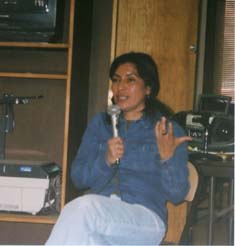
Elizabeth Peredo
Elizabeth Peredo's presentation was another graphic
example of this scenario, but at least in the short term, a
victory for the people. Even though Bechtel fled the
country, Bolivia is now being sued by the conglomerate to
recover $25 million of "potential lost profits" under the
protection of the North American Free Trade Agreement
(NAFTA). Peredo is hope-ful that the new Bolivian government
elected last year will proactively fight this suit against
its people. She also pointed out that the struggle in her
country has helped make people more aware of conserving and
protecting their water resources (a coalition between rural
and urban communities has formed to protect water at its
source) and has empowered women, who were on the front line
of the struggle.
In the afternoon, José Luís Montes of the
Solidarity Task Force of Human Rights in Chihuahua, Mexico,
spoke about how the 1944 treaty between Mexico and the
United States is pitting Texas ranchers against Chihuahuan
farmers and others of the Rio Concha watershed, whose crops
and animals are dying and are even without drinking water.
He stressed that the drought "doesn't respect borders" and
that the Texas ranchers must release water into the Rio
Concha so the indigenous people can manage their own
resource.
A panel of New Mexicans, including Richard Moore of the
Southwest Network for Environmental and Social Justice in
Albuquerque, Germán Agoyo of San Juan Pueblo, Kathy
and Gilbert Sanchez of San Ildefonso Pueblo, and Kay
Matthews of La Jicarita News, provided an overview of water
issues in New Mexico, explaining how these same forces
described by Case, Peredo, and Montes affect the equitable
distribution and management of water in our state. They all
stressed the importance of community control of water, but
recognized that conflicts among constituencies - pueblos,
non-Indian rural communities, environmentalists and the
state - still largely drives the dialogue.
ANNOUNCEMENTS
The Cry of the Poor
A Call to Peacemaking
The 22nd annual Prayer Pilgrimage for Peace from
Chimayó to Los Alamos will take place on Saturday,
April 17. The guest speaker will be Sister Dianna Ortiz,
native New Mexican, missionary to Guatemala, and founder and
director of the Torture Abolition and Survivor's Support
Coalition (TASSC). The schedule is as follows:
8:00 am: Gather at Holy Family Church in Chimayó,
opening prayer with Gerald Nailor, Governor, Picuris Pueblo,
send runners to Los Alamos.
9:00 am: Mass followed by 3 mile Walking Prayer
Pilgrimage to Chimayó Santuario led by Los Hermanos
of Northern New Mexico.
11:00 am: Interfaith sharing and bread circle at
Santuario and lunch.
1:00 pm: Car pilgrimage to Ashley Pond at Los Alamos.
1:45 pm: Music, dances of peace and reflections at Ashley
Pond.
2:30 pm: Welcoming of runners, blessing of earth with
Governor Nailor, reflections offered by Sister Ortiz,
closing prayer and circle for peace around Ashley Pond.
Pilgrims should wear comfortable shoes and layered
clothing and bring a sack lunch. Sponsored by the Office of
Social Justice, Archdiocese, Santa Fe. Call 831-8205 or
David Fernandez at 758-7608.
• The Second Annual Conference of the Adobe
Association of the Southwest will take place on May 21, 22,
and 23 on the campus of Northern New Mexico Community
College in El Rito. The conference will look beyond just the
mud and bricks of adobe at some of the cultural, social, and
economic impacts, including the contribution of women. It
will also address the following topics: affordable adobe
construction; thermal properties of earthen materials;
historical buildings of note in the United States;
historical architects/designers of note; historical
developers/ planners of note; new projects; adobe education;
manufacture and supply of construction materials. To
register, contact Quentin Wilson at 505-581-4156 or
qwilson@mail. nnmcc.edu. The schedule is as follows:
Friday, May 21
11 am to 1 pm: Registration
1:30 pm to 4:40 pm: Session I
5 pm to 6:30 pm: Dinner
7 pm to 9 pm: Social hour
Saturday, May 22
9:30 am to 12 pm: Session II
1:30 am to 12 pm: Tour
7 pm to 9 pm: Session III
Sunday, May 23
9:30 am to 12 pm: Session IV
A Better New Mexico is Possible!
Countering Globalization and Building our Local
Economy
April 30-May 2, 2004
Friday Evening / Saturday / Sunday
at the Forum, The College of Santa Fe.
Come hear how the global economic system affects us
locally. Discuss alternative visions and sound strategies
for building life-affirming economic structures. Strengthen
your organizing skills and join with others to implement
initiatives that build our local economy. Together we can
create a vibrant New Mexico for our children!
With Many Leading New Mexican Community Organizers.
Panels will include: Global versus Local Food Systems,
Border/Labor/Immigration Issues, Land Grants and Acequias,
Environmental Racism, Building Energy Self-Reliance, Ecology
and Human Health, Supporting Peoples‚ Movements in the
"Third World," and much else!
And Internationally Renowned Voices: Onesimo Hidalgo,
CIEPAC (Centro de Investigaciones Económicas y
Políticas de Acción Comunitaria); Kevin
Danaher, Global Exchange; Helena Norberg-Hodge,
International Society for Ecology and Culture; Michael
Shuman, author of Going Local
Cost: Full Program: $100; Fri. or Sat. Eve: $17;Per Day
Rate (including evenings): $60; Per Session Fee: $10..
Inquire regarding student rates and scholarships.
Registration at www.nonviolenteconomics.org or by calling
the Institute at 995-9793.
• The Online Civilian Conservation Corps Museum is
seeking stories about the CCCs, CCC Enrollees, Staff, or
Technical Advisors for publication in this online historical
resource. If you would like to participate please send your
stories, with name, company, number, and location, if known,
to CCC Collection, P.O. Box 5, Woodbury NJ 08096 or e-mail
JFJ museum@ aol.com.
• Drought and a growing population have made water
conservation and protection of water quality more important
than ever before. The next generation will be better able to
deal with the challenge if they start gaining skills and
awareness of water resources now. With this in mind, La
Jicarita Enterprise Community is hosting a water education
workshop for area educators on May 5, 2004 at the
Peñasco School. This free workshop will be
taught by Bryan Swain, New Mexico's Project WET Coordinator,
and Ryan Weiss, the Education Program Coordinator for Eight
Northern Indian Pueblos Council. Each participating teacher
will receive a personal copy of the Project WET Curriculum
and Activity Guide, which contains materials for more than
90 water education activities. During the workshop,
several of these activities will be presented, including
"Raining Cats and Dogs" (which emphasizes literacy and
geography), "The Incredible Journey" (on the water cycle),
"Pass the Jug" (on water rights and allocation), and
"Branching Out" (on watershed mapping).
Interested teachers should register by April 28th by
calling Ruby Lopez (Peñasco Independent School
District) at 587-2230, extension 2. For more information,
call Cordell Arellano (La Jicarita Enterprise Community) at
587-0074.
• Check out the new agricultural website
www.e-plaza.org (more on this project in the May/June
issue)
The Water Market Game
By Kay Matthews
Reprinted with permission from the El Dorado Sun
At the Santa Fe hearing on the State Water Plan in the
summer of 2003 environmentalists, acequia parciantes,
farmers, ranchers, and city residents all told the
Interstate Stream Commission (ISC - authors of the plan)
that unless growth in Santa Fe and Albuquerque is limited we
will run out of water - period. At the Las Vegas and Taos
hearings the same message was conveyed, this time from the
heart of acequia communities that could be the big losers in
a water market game. And at the three-day Town Hall meeting
in Albuquerque, it was pounded home even harder: no amount
of water conservation, water banking, water delivery systems
[see article on pages 4 and 5], desalination plants,
or combinations thereof is going to solve our water woes if
we don't do something to stop the developers from turning
Albuquerque into Los Angeles and Santa Fe into a desert
wasteland.
Planning staff at the ISC drafted the water plan at the
behest of Governor Bill Richardson (also mandated by the
state legislature in 2003). It took a year's worth of public
hearings and consultation with State Engineer John D'Antonio
and members of the Water Trust Board (WTB), comprised of
representatives of diverse constituencies including acequia
and irrigation communities, Native Americans,
environmentalists, and various state agencies. The final
draft version of the plan was presented to the governor and
the Interstate Stream Commission for their approval in
mid-December. Implementation of the plan is both statutory
(authorized by state statute) and legislative; the latter
will be necessary to fund state agencies responsible for
carrying out the plan's various components.
ISC director Estevan Lopez, in charge of the plan's
promulgation, brings experience as a Peñasco acequia
parciante as well as former Santa Fe County manager, dealing
on a daily basis with urban growth and development issues.
In an interview last February with La Jicarita News Lopez
said, "The criticism of cities is, where does growth end? Or
should we be looking at stopping growth? These discussions
need to be opened up even if they're difficult and
emotional. I don't know if this will provide solutions but
at least you start getting at some of the root issues
instead of one side saying, 'We can't have any more growth
because we don't have enough water,' and the other side
saying, 'You're just saying that so you can control growth.
Let's have a discussion about the growth, then."
While that dialogue did take place in many of the public
hearings on the plan, the final version largely ignores this
debate and devotes many pages to "making more water":
"creating" more drinking water with desalination plants;
conserving water through more efficient delivery systems;
banking water (temporarily reallocating water); and of
course, buying and selling water on the open market. A
policy statement in Section C.2 of the plan reads, "The
State shall promote water markets that enable the efficient
movement of water rights within the State in accordance with
the applicable legislative and legal safeguards." The plan
goes on to say, "As water demands from expanded existing and
new uses increase, the demand for marketing of water through
these voluntary transfers of existing water rights will
grow." (The word voluntary was added to the language in the
Draft Final.)
This is the direction water policy has been headed the
past 20 years: commodification and movement of water to the
"highest and best use", meaning, of course, whoever can come
up with the most money gets the most water. Currently
sitting as "Representative of the Environmental Community"
on the WTB, Denise Fort was chair of the Western Water
Policy Review Advisory Commission, a committee mandated in
1992 to define the federal role in water policy for the 19
western states. The report released by that commission,
Water Management Study: Upper Rio Grande River Basin,
states, "We recommend federal agencies in the [Rio
Grande] Basin do more to mitigate the constraints to
competition that keep water and other resources in low-value
uses while high value demands go unmet." The report goes on
to say that acequia associations and irrigation and
conservancy districts have exercised undue influence on
legislation pertaining to water distribution in the state
and the Rio Grande Compact "reflects the agrarian economy .
. . that existed at the end of the 1920s, not today's highly
urbanized economy." Even new innovations such as water
banking programs, which the 2003 legislature approved,
should, according to the report, only be supported by
federal agencies if they determine "that the bank will
facilitate voluntary transfer of water to highest-value
uses."
The commodification of water has long been a concern of
the New Mexico Acequia Association (NMAA), an advocacy group
of acequia parciantes and associations across the state. The
NMAA was instrumental in helping pass legislation last year
that allows acequia systems to bank unused water (water that
would be reallocated within the acequia system) and to adopt
a provision in their bylaws that gives commissioners the
authority to deny proposed water transfers if they would
impair the acequia's operation.
At the October 2003 hearing in Santa Fe on the Draft
Water Plan, Paula Garcia, director of the NMAA and
representative of acequia parciantes on the WTB, asked that
the water plan protect acequia water rights under the Treaty
of Guadalupe Hidalgo and that acequia communities be treated
as a distinct entity along with Native American pueblos. She
objected to the language in the plan that essentially
defines the Office of the State Engineer (OSE) as a
"facilitator" of water markets rather than a "regulator" in
this process that threatens the water rights of rural
northern New Mexico. Trudy Valerio Healy of Arroyo Hondo,
the WTB representative of irrigation districts, shares
Garcia's concerns. "Some rural areas may sell their water to
urban areas, then become ghost towns," she warned.
ISC director Lopez and State Engineer D'Antonio point out
that the plan is a "working document" that will evolve over
time to incorporate public concerns and technical
information that continues to be gathered. In response to
Garcia's concerns, which were raised by many others at all
the public meetings, the final version references that
"acequias assert certain protections under the Treaty of
Guadalupe Hidalgo" and that "Nothing in the State Water Plan
will impair or limit the claims that these Native American
and acequia water-rights holders assert."
In the meantime, the OSE continues to adjudicate stream
systems, which essentially privatizes water rights that have
been used as common rights in acequia and pueblo communities
for hundreds of years. The adjudication process is also an
adversarial one, pitting the state against individual water
users who must defend their water rights in a lengthy,
litigious process that takes years to complete.
This process of privatization has larger implications in
the global water market. As Maude Barlow points out in her
definitive book on water privatization, Blue Gold: The Fight
to Stop the Corporate Theft of the World's Water, "Citizens
of the most privileged countries simply take water for
granted or are able to buy it . . . [and] their
lifestyles - SUVs, lawns, and golf courses" are a leading
factor in "consumption disparity between rural and urban
areas, the rich and the poor." Global water cartels will
certainly not provide water to all, and those they do will
pay dearly for it, like the citizens of Cochabamba, Bolivia,
who successfully fought off a consortium led by Bechtel
Corporation (now making millions in Iraq), with whom the
Bolivian government contracted to take over the municipal
water system [see article on page 1].
Could this be the scenario in New Mexico? Certainly the
tension between urban and rural and rich and poor will be
exacerbated as water is increasingly commodified and sold on
the open market. That's why so many of the policies
implemented by our city councils and county commissions and
now codified in the State Water Plan make little sense to
the people who came to the Water Plan hearings and told the
planners that New Mexico is a desert state with a carrying
capacity that has already been exceeded.
Albuquerque and Santa Fe want to build diversion dams to
access San Juan/Chama water rights that may soon be
nonexistent. If the current drought continues, the flow from
these rivers into Heron Reservoir may be reduced to a
trickle, especially in light of the fact that upstream
Navajo rights are senior rights that will keep the water
from ever entering the diversion tunnel. Buying acequia
water rights, which Healy fears will turn our rural villages
into ghost towns will also turn our tourist economy into a
fond memory - or not so fond for some folks - once the
fields, wildlife habitat, and open space the acequias
support dry up. If "management" of our water resources -
that is, conservation, new diversion projects, the purchase
of water rights, new technology, and conjunctive use
(combined surface and ground water) - merely facilitates
unlimited residential and commercial growth, we are indeed
headed towards social and environmental collapse.
To buy into the "grow or die" argument is to fail to
recognize the difference between economic growth and
economic development. Several years ago, Maria Varela,
longtime New Mexico community activist, wrote a paper on
this issue. "Growth increases the amount of money running
through a community's economy but may not increase that
economy's capacity to steer its own direction. Growth is
characterized by dependence on outside capital, technologies
and management talent. Economic development, conversely,
increases the capacities of the people in the community to
attract and pool capital and acquire technologies and
management skills. Most of the wealth stays in the
community." Our finite water resources must be used to
support economic development, not growth, and until the
powers that be also acknowledge this concept, the State
Water Plan is, as one citizen commented at the hearing on
the draft plan, "full of sound and fury, signifying
nothing."
|
Puntos de Vista
By Orlando Romero, Nambe Resident and Historian
Editor's Note: What follows is the resignation
letter that Vice-President Orlando Romero of the Pojoaque
Valley Water Users Association wrote President David Ortiz
on February 9. Below the letter is an explanation of the
proposed Aamodt settlement.
Dear David:
Regarding our conversation of February 4, 2004, and for
the record, the following points are the reasons that lead
me to resign my position on the board of the PVWUA.
The so-called settlement or resolution of the Aamodt case
with the Pueblos has so many unanswered issues, questions,
ambiguities and is so poorly conceived that I for one cannot
support the results. My rationale is based on the
following:
1. Secrecy. Although we were advised by our legal counsel
that the settlement hearings had to be held in secrecy
because of their political nature, we do live in a democracy
and in a democracy, agreements signed and conducted in
secrecy usually are not worth the paper they are written on.
People in this valley, including Chupadero, Tesuque,
Cuyamungue, Pojoaque, Nambe, Jacona, El Rancho, etc., are
very well aware that all hearings were held in secrecy and
that they had no input regarding their water rights,
especially having to give up their wells. How do we justify
this lack of democracy?
2 Priorities. Our legal counsel has advised us that if
the Pueblos decide to call on the priority rights awarded to
them by Judge Mechem's decision, there will be no water left
for the non-Indians for either acequias or wells.
Politically, this would be a disaster for the Pueblos.
Thousands of angry water users would protest to their
respective county, state and federal representatives. In the
midst of a drought, while the Pueblos continue to water golf
courses, to use this rationale for settling or resolving
this suit is faulty at best.
3. Contractual Agreements. The broken gambling compacts
approved by federal and state governments with the Pueblos
are an excellent example why this settlement should not be
agreed to. Even as I write, gambling compacts are now, once
again, being renegotiated. The Pueblos have enormous
resources from their casinos for lawyers. How can we be
reassured that they won't come back, time and again, to
"renegotiate" this settlement?
4. Giving Up Our Wells. Explain the logic of having to
give up our wells and consolidate those rights in a water
"company" or city/county water association so that the
county can tap into and continue their uncontrolled growth.
Doesn't that defeat the purpose of trying to salvage the
stream flow of the Rio Nambe? And if Pojoaque Pueblo is
going to receive an additional 300 acre feet of water from
this deal, how are we as board members going to justify
these additional water rights, especially when the Pueblo
continues to water golf courses in the midst of a prolonged
drought while our valley folk have to give up their
wells?
5. Irrigators. Are we to believe that well users are
going to give up their wells so that the few who still
irrigate can keep irrigating? You know as well as I do that
the county has allowed prime irrigated land to be developed
into 3/4 acre home sites. There are now more well users than
irrigators.
6. Irrigation Wells. Why and who negotiated into this
settlement that "irrigation" wells are exempt from the rest
of the wells because they take their source water "directly
from the stream flow"? You know as well as I do that many of
these so-called deep irrigation wells are owned by very
powerful people and are nowhere near the source of direct
stream flow.
7. San Juan Water. As a researcher, historian and
small-time farmer, I am supremely aware that there is a huge
difference between paper water rights and real, honest
flowing water in a ditch or pipeline. San Juan water during
this prolonged drought is almost nonexistent. The Azotea
tunnel has realistically, for all practical purposes, been
shut off. Look at Heron Lake; it looks like a pond. And the
Navajos are next in line to get priorities off this flow, so
how can the city, county, state or feds base a settlement on
such a tenuous supply of water - unless the real intent is
to divert all our well rights to these massive new water
fields at San Ildefonso?
8. The Ranney Water Fields. The presumption that these
new "water fields" can take direct source water from the Rio
Grande with minimal filtration is very bad science. Ongoing
ecological studies are showing that the most sophisticated
water treatment plants cannot filter or treat antibiotics
and antidepressants that go through treatment plants and are
then returned to rivers and waterways. Above the proposed
Ranney water fields, the cities of Española and Taos
discharge their treated water into the Rio Grande. How can
we honestly tell the people of the valley and the county
that their new piped water is cleaner than the water they
get from their individual wells?
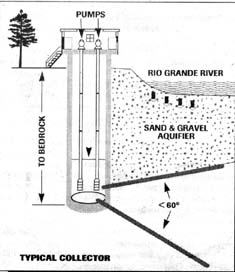
9. City/County Water Board. As I write this letter, the
Legislature is trying to pass a bill that would allow the
city and county to create a water board that would have
condemnation rights on our wells. Is this the same water
board that is proposed to run the Ranney fields system and
so-called Pueblo pipeline that does not exist yet? If not,
where is this new water board going to get its water? What
is its point of diversion?
And most important, our legal counsel, both in private
and in public, assured us that we were going to have the
right of refusal if we did not agree with the proposed
Aamodt settlement, especially regarding the issue of giving
up our wells. Why is this board and legal counsel advocating
this new water board that can condemn our wells? Is this the
back door way of telling us "accept the settlement or the
county will condemn your wells anyway?"
10. Hookups. How are we to pay for this new water system
after our wells have been taken from us? More taxes? How are
poor people supposed to pay for this "service"?
I hope you understand why I can no longer serve on this
board. I joined this board to serve my community. Instead, I
feel that I've been used by lawyers and politicians who
cannot or will not serve the needs of their clients or their
constituents I don't see much democracy in these
negotiations. Instead, there is secrecy and back door deals
in which I do not wish to participate.
Sincerely,
Orlando Romero
Editor's Note: Subsequent to Orlando's resignation
from the Pojoaque Valley Water Users Association, a new
group, the Pojoaque Basin Water Alliance (PBWA), was formed
by defendants in the Aamodt case to represent the interests
of well owners in the Pojoaque Basin. In its March 26 press
release, the Alliance "seeks a settlement which is fair and
equitable for all defendants." The group is trying to
educate the public about the potential effects of this
proposed settlement and the legal precedents it could set.
PBWA will hold its first public meeting on Wednesday, March
31, 7 pm, in the Frank B. Lopez Gym at Pojoaque Valley High
School. For more information contact Julia Takahashi at
455-7069 or Orlando Romero at 455-3315.
The Settlement Agreement
The proposed settlement to the Aamodt lawsuit, which is
the subject of Orlando's letter, refers to a lawsuit that
was originally filed in 1966 to determine the extent of
water rights of non-Indians and Indian Pueblos in the
Tesuque, Nambe and Pojoaque watersheds. Under the priority
system that has been adopted by the state of New Mexico,
those who first put the water to "beneficial use" have
priority in times of shortage. This means that the Pueblos,
which hold the senior most rights, could petition the court
to cut off diversions by junior water rights owners until
their full assessment has been met.
The settlement proposal identifies three tiers of
priority: first, the Pueblos of Tesuque, Nambe, Pojoaque and
San Ildefonso's existing water rights, which amount to 1,391
acre feet (an acre foot is approximately 326,000 gallons)
and their development rights to 2,269 additional acre feet;
second: the existing water rights (both surface and ground)
of approximately 2,200 non-Indian households within the
valley with the proviso that all existing domestic wells be
capped and those ground water rights transferred to a
proposed water delivery and wastewater treatment facility;
and third, 2,500 additional acre feet for future pueblo
development. In addition, the settlement calls for the
construction of a pipeline which would transport effluent
from the waste treatment facility to the Pueblo of Pojoaque
for irrigating its golf courses.
The proposed water delivery and wastewater treatment
facility will cost an estimated $280 million, of which the
federal government would pay $212 million. (This federal
funding has not been secured and hinges on Senator
Domenici's clout within Congress.) The diversion for the
facility (what Orlando refers to as the Ranney water fields)
would be on the Pueblo of San Ildefonso, which has not as
yet negotiated agreements to access that facility. Moreover,
the diversion would be above the Otowi gauge but would
service areas both above and below the gauge. Historically,
the State Engineer has not permitted water diverted above
the gauge to be used below the gauge. Water rights owners
above the gauge have expressed concern that this could set a
precedent that would allow municipalities and developers
below the gauge to shop for water rights above the
gauge.
Marching to End the
Occupation of Iraq
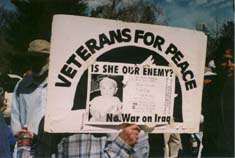
On March 20 millions people in New York, San Francisco,
London, Rome, Tokyo, and Madrid rallied and marched to send
a message to the Bush administration that they oppose the
continued occupation of Iraq and other imperial wars being
waged around the world. In Santa Fe, hundreds of peace
activists gathered at the Roundhouse to listen to speakers
before marching to the Plaza with their banners, signs, and
chants, "Bring the Troops Home Now." Father John Dear,
activist priest and member of the Ploughshares community,
told the crowd about his plea to National Guard troops in
front of his house in Springer to lay down their weapons.
Santiago Juarez urged people to get out the vote in the
critical presidential election and sent organizers
throughout the crowd to register voters. Miguel Angel, of
the Las Vegas Committee for Peace and Justice, spoke of the
many wars and occupations the United States has perpetrated
around the world. And Chopper Sic Balls, a Santa Fe punk
band, exhorted the crowd to embrace the diversity of peoples
here at home and around the world.
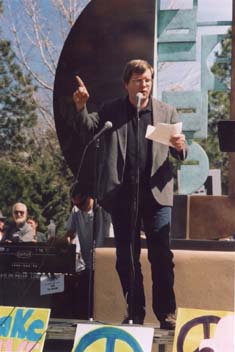
Father John Dear
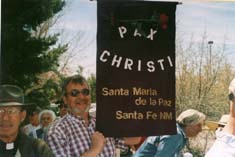

Santiago Juarez, director of P.A.C.E. New
Mexico
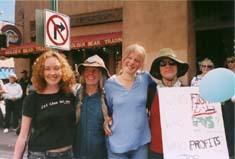
Edge Habitat family members Sarah, Mary, Aspen, and
friend Emmy
Who's Reading La
Jicarita?
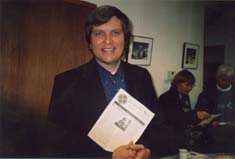
Father John Dear
|









